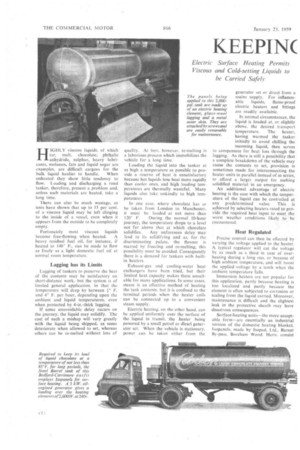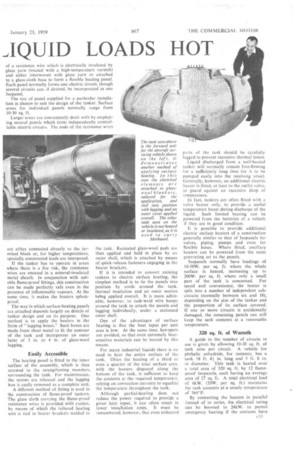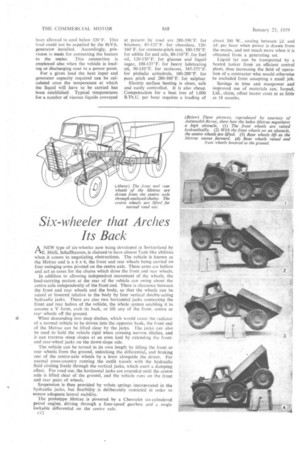KEEPIN( AQUID LOADS HOT
Page 46

Page 47

Page 48

If you've noticed an error in this article please click here to report it so we can fix it.
HIGHLY viscous liquids, of which tar, malt, chocolate, phthalic anhydride, sulphur, heavy lubricants, molasses, fats and liquid sugar are examples, are difficult cargoes for the
bulk liquid haulier to handle. When unheated they show little tendency to flow. Loading and discharging a road tanker, therefore, present a problem and, unless such materials are heated, take a long time.
There can also be much wastage, as tests have shown that up to 15 per cent. of a viscous liquid may be left clinging to the inside of a vessel, even when it appears from the outside to be completely empty.
Fortunately most viscous liquids become free-flowing when heated. A heavy residual fuel oil, for instance, if heated to 140° F., can be made to flow as freely as a light domestic fuel oil at normal room temperature.
• Lagging has its Limits
Lagging of tankers to preserve the heat of the contents may be satisfactory on short-distance work, • but the system is of limited general application, in that the temperature will drop by between -1-" F. and 4' F. per hour, depending upon the ambient and liquid temperatures, even when protected by 4-in.-thick lagging.
If some unavoidable delay occurs on the journey, the liquid may solidify. The cost of such a mishap will vary greatly with the liquid being shipped, as some deteriorate when allowed to set, whereas others can be re-melted without loss of quality. At best, however, re-melting is a laborious process which immobilizes the vehicle for a long time.
Loading the liquid into the tanker at as high a temperature as possible to provide a reserve of heat is unsatisfactory because hot liquids lose heat more rapidly than cooler ones, and high loading temperatures are thermally wasteful, Many liquids also take unkindly to high temperatures In one case, where chocolate has to be taken from London to Manchester. it must be loaded at not more than 120° F. During the normal 10-hour journey, the temperature drops to a level not far above that at which chocolate solidifies. Any unforeseen delay may lead to its solidifying and as, for the discriminating palate, the flavour is marred by freezing and re-melting, this possibility must be avoided. Consequently there is a demand for tankers with builtin heaters.
Exhaust-gas and cooling-water heat exchangers have been tried, but their limited heat capacity makes them unsuitable for many applications. In some cases. steam is an effective method of heating the tank contents, but it is confined to the terminal periods when the heater coils can be connected up to a convenient steam supply.
Electric heating. on the other hand, can be applied uniformly over the surface of the liquid in transit, the heater being powered by a small petrol or diesel generator set. When the vehicle is stationary, power can he taken either from the generator set or direct from a mains supply. For inflammable liquids, flame-proof electric heaters and fittings are readily • available.
In normal circumstances, the liquid is loaded at, or slightly above, the desired transport temperature. The heater, having warmed the tanker initially to avoid chilling the incoming liquid, then serves to compensate for heat loss through the lagging. As there is still a possibility that a complete breakdown of the vehicle may cause the contents to set, provision is sometimes made for interconnecting the heater units in parallel instead of in series, to afford a larger output for melting solidified material in an emergency.
An additional advantage of electric heating is the ease with which the temperature of the liquid can be controlled at any predetermined value. This is achieved by selecting heaters rated to provide the required heat input to meet the worst weather conditions likely to be encountered.
Heat Regulated
Precise control can then be effected by varying the voltage applied to the heater. A typical regulator will cut the voltage by as much as a third in case of overheating during a long run, or because of high ambient temperature, and will boost the applied voltage by a tenth when the ambient temperature falls.
Immersion heaters are not popular for this application, partly because heating is too localized and partly because the element is often subjected to corrosion or scaling from the liquid carried. Moreover, maintenance is difficult and the slightest leak in the protective sheath may have disastrous consequences.
Surface-heating units—the more acceptable form—are essentially an industrial version of the domestic heating blanket. Isopanels. made by Isopad, Ltd., Barnet By-pass. Boreharn Wood, He consist of a resistance wire which is electrically insulated by glass yarn (treated with a high-temperature varnish) and either interwoven with glass yarn or. attached to a glass-cloth base to form a flexible heating panel. Each panel normally forms one electric circuit, though several circuits can, if desired, be incorporated in one Isopanel.
The size of panel supplied for a particular installation is chosen to suit the design of the tanker. Surface areas for individual panels normally range from 10-30 sq. ft.
Larger 'areas are conveniently dealt with by employing several panels which form independently controllable electric circuits. The ends of the resistance wires are either connected directly to the terminal block or, for higher temperatures, specially constructed leads are interposed.
If the tanker has to operate in areas where there is a fire risk, the resistance wires are encased in a mineral-insulated metal sheath. In conjunction with suitable flame-proof fittings, this construction can be made perfectly safe even in the presence of inflammable vapours. At the same time, it makes the heaters splashproof.
The way in which surface-heating panels are attached depends largely on details of tanker design and on its purpose. One method is to apply the heaters in the form of "lagging boxes." Such boxes are made from sheet metal to fit the contour of the tank and incorporate an outer layer of 3 in. or 4 in. of glass-wool lagging.
Easily Accessible
• The heating panel is fitted to the inner surface of the assembly, which is then screwed to the strengthening members. surrounding the tank. For maintenance, the screws are released and the lagging box is easily removed as a complete unit.
A different method of fitting is used in the construction of flame-proof tankers. The glass cloth carrying the flame-proof resistance wires is provided with eyelets, by means of which the tailored heating unit is tied to bearer brackets welded to the tank. Resinated glass-wool pads are then applied and held in place by an outer shell, which is attached by means of quick-release fasteners engaging in the bearer brackets.
If it is intended to convert existing tankers to electric surface heating, the simplest method is to tie the panels into position by cords around the tank, thermal insulation and an outer section being applied overall. It is more advisable, however, to tack-weld wire hoops around the tank to attach the panels and lagging individually, under a sectioned outer shell.
One of the advantages of surface heating is that the heat input per unit area is low. At the same time, hot-spots are avoided, so that even extremely heatsensitive materials can be heated by this means.
For many industrial liquids there is no need to heat the entire surface of the tank. Often the heating of a third or even a quarter of the total surface area, with the heaters disposed along the bottom of the tank, is sufficient to keep the contents at the required temperature, relying on convection currents to equalize the temperature throughout the tank.
Although partial-heating does not reduce the power required to provide a given heat input, it can often result in lower installation costs. It must be remembered, however, that even unheated parts of the tank should be carefully lagged to prevent excessive thermal losses.
Liquid discharged from a well-heated tanker will normally remain free-flowing for a sufficiently long time for it to be pumped easily into the receiving vessel. Generally, however, an additional electric heater is fitted, at least to the outlet valve, to guard against an excessive drop of temperature.
In fact, tankers are often fitted with a valve heater only, to provide a useful temperature boost during discharge of the liquid. Such limited heating can be powered from the batteries of a vehicle if they are in good condition.
It is possible to provide additional electric surface heaters of a construction generally similar to that of Isopanels for valves, piping, pumps and even for flexible hoses. Where fitted, ancillary heaters can be powered from the same generating set as the panels.
Isopanels normally have loadings of 10-50W, per sq. ft. where the whole surface is heated, increasing up to 200W. per sq. ft. where only a small part of the tank is concerned. For speed and convenience, the heater is split into a number of independent subcircuits (normally between six and 18), depending on the size of the tanker and the proportion of its surface covered. If one or more circuits is accidentally damaged, the remaining panels can still keep the tank contents at a reasonable temperature.
320 sq. ft. of Warmth
A guide to the number of circuits to use is given by allowing 10-30 sq. ft. of tank area per circuit. A vehicle for phthalic anhydride, for instance, has a tank 18 ft. 41 in. long and 5 ft. 8 in. in diameter. This tank is heated over a total area of 320 sq. ft. by 12 flameproof Isopanels, each having an average area of 27 sq. ft. A total electrical load of 6kW. (20W. per sq. ft.) maintains the tank contents at a steady temperature of 360°F.
By connecting the heaters in parallel instead of in series, the electrical rating can be boosted to 24kW. to permit emergency heating if the contents have been allowed to cool below 320°F. This load could not be supplied by the 8kVA. generator installed. Accordingly, prbvision is made for connecting the heaters to the mains. This connection is employed also when the vehicle is loading or discharging near to a power point.
For a given load the heat input and generator capacity' required can be calculated once the temperature at which the liquid will, have to be carried has been established. Typical temperatures for a number of viscous liquids conveyed at present by road are 280-390°F. for bitumen, 85-125°F. for chocolate, 120160°F. for creosote-pitch mix, 100-150°F. for edible fat and oils, 80-110°F. for fuel oil, 120-130°F. for glucose and liquid sugar, 100-135°F. for heavy lubricating oil, 90-110°F. for molasses, 345-375°F. for phthalic anhydride, 180-200°F. for pure pitch and 280-300°F. for sulphur.
Electric surface heating is clean, safe and easily controlled. It is also cheap. Compensation for a heat loss of 1,009 B.Th.U. per hour requires a loading of about 300 W., costing between id. and Id. per hour when power is drawn from the mains, and not much more when it is obtained from a generating set.
Liquid tar can be transported by a heated tanker from an efficient central plant, thus increasing the field of operation of a contractor who would otherwise be excluded from accepting a small job.
Savings in time and manpower and improved use of materials can, Isopad, Ltd., claim, offset heater costs in as little as 18 months.




































































































































































































